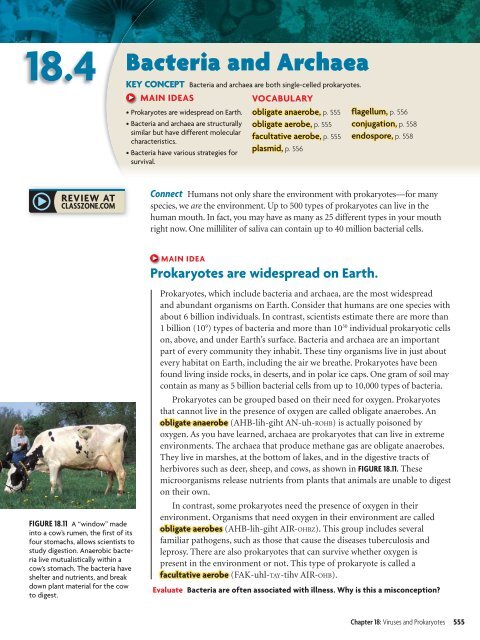18.1 Studying Viruses and Prokaryotes
18.1 Studying Viruses and Prokaryotes
18.1 Studying Viruses and Prokaryotes
Create successful ePaper yourself
Turn your PDF publications into a flip-book with our unique Google optimized e-Paper software.
18.4Bacteria <strong>and</strong> ArchaeaKEY CONCEPT Bacteria <strong>and</strong> archaea are both single-celled prokaryotes.MAIN IDEAS• <strong>Prokaryotes</strong> are widespread on Earth.• Bacteria <strong>and</strong> archaea are structurallysimilar but have different molecularcharacteristics.• Bacteria have various strategies forsurvival.VOCABULARYobligate anaerobe, p. 555obligate aerobe, p. 555facultative aerobe, p. 555plasmid, p. 556flagellum, p. 556conjugation, p. 558endospore, p. 558Connect Humans not only share the environment with prokaryotes—for manyspecies, we are the environment. Up to 500 types of prokaryotes can live in thehuman mouth. In fact, you may have as many as 25 different types in your mouthright now. One milliliter of saliva can contain up to 40 million bacterial cells.FIGURE <strong>18.1</strong>1 A “window” madeinto a cow’s rumen, the first of itsfour stomachs, allows scientists tostudy digestion. Anaerobic bacterialive mutualistically within acow’s stomach. The bacteria haveshelter <strong>and</strong> nutrients, <strong>and</strong> breakdown plant material for the cowto digest.MAIN IDEA<strong>Prokaryotes</strong> are widespread on Earth.<strong>Prokaryotes</strong>, which include bacteria <strong>and</strong> archaea, are the most widespread<strong>and</strong> abundant organisms on Earth. Consider that humans are one species withabout 6 billion individuals. In contrast, scientists estimate there are more than1 billion (10 9 ) types of bacteria <strong>and</strong> more than 10 30 individual prokaryotic cellson, above, <strong>and</strong> under Earth’s surface. Bacteria <strong>and</strong> archaea are an importantpart of every community they inhabit. These tiny organisms live in just aboutevery habitat on Earth, including the air we breathe. <strong>Prokaryotes</strong> have beenfound living inside rocks, in deserts, <strong>and</strong> in polar ice caps. One gram of soil maycontain as many as 5 billion bacterial cells from up to 10,000 types of bacteria.<strong>Prokaryotes</strong> can be grouped based on their need for oxygen. <strong>Prokaryotes</strong>that cannot live in the presence of oxygen are called obligate anaerobes. Anobligate anaerobe (AHB-lih-giht AN-uh-ROHB) is actually poisoned byoxygen. As you have learned, archaea are prokaryotes that can live in extremeenvironments. The archaea that produce methane gas are obligate anaerobes.They live in marshes, at the bottom of lakes, <strong>and</strong> in the digestive tracts ofherbivores such as deer, sheep, <strong>and</strong> cows, as shown in FIGURE <strong>18.1</strong>1. Thesemicroorganisms release nutrients from plants that animals are unable to digeston their own.In contrast, some prokaryotes need the presence of oxygen in theirenvironment. Organisms that need oxygen in their environment are calledobligate aerobes (AHB-lih-giht AIR-OHBZ). This group includes severalfamiliar pathogens, such as those that cause the diseases tuberculosis <strong>and</strong>leprosy. There are also prokaryotes that can survive whether oxygen ispresent in the environment or not. This type of prokaryote is called afacultative aerobe (FAK-uhl-TAY-tihv AIR-OHB).Evaluate Bacteria are often associated with illness. Why is this a misconception?Chapter 18: <strong>Viruses</strong> <strong>and</strong> <strong>Prokaryotes</strong> 555
















